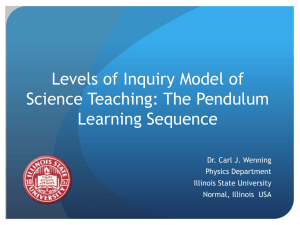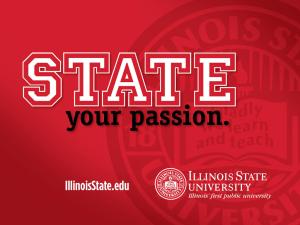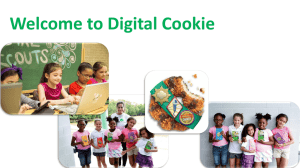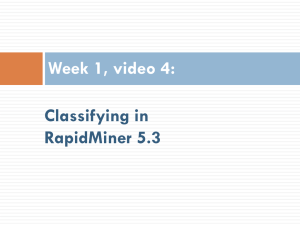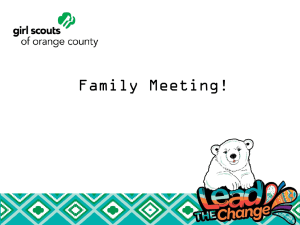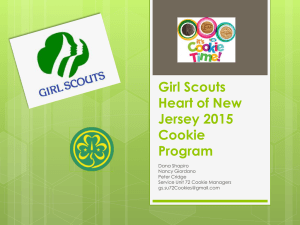NC Inquiry - Currituck County Schools
advertisement
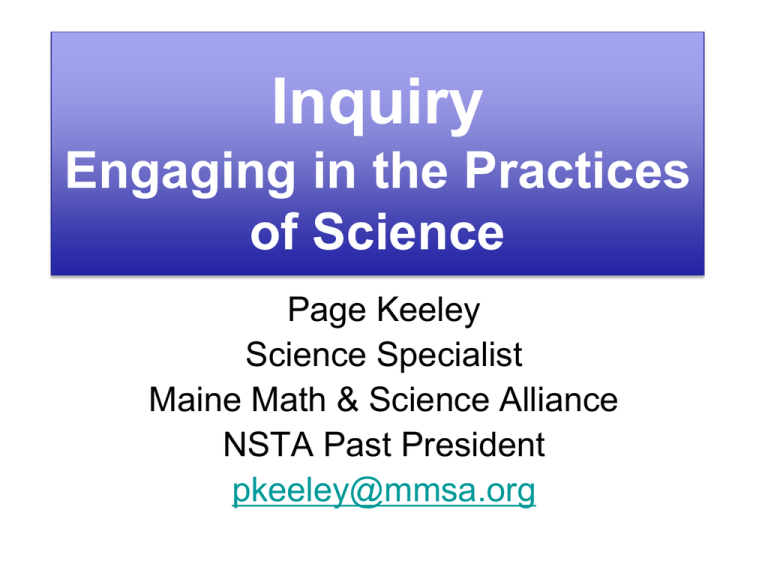
Inquiry Engaging in the Practices of Science Page Keeley Science Specialist Maine Math & Science Alliance NSTA Past President pkeeley@mmsa.org Who’s in the room? Our Goal and Approach To build an understanding of science as inquiry (K-12) as it applies to the current direction of science education and the North Carolina standards. Tang Yan is a Chinese teacher visiting your school district. She wonders what your district means by “inquiry science”. How would you describe inquiry science to Tang Yan? Describing Science as Inquiry • Students take an active role in science learning. • Involves content and process. • Investigating for the purpose of constructing understanding of natural phenomena, processes, and events. • Gives priority to evidence and evidencebased explanations • Mirrors science as practiced by scientists Science as inquiry is key to organizing and guiding students' activities. Students in all grades and in every scientific discipline should have the opportunity ask questions, plan and conduct investigations, use appropriate tools and techniques to gather data, think critically and logically about relationships between evidence and explanations, and communicate arguments. (from the NC standards) All this begs the question—do students have to be involved in a hands-on investigation to inquire? Not really. The key, often forgotten, aspect of inquiry is that it is an intellectual endeavor. Too many students have a knack for being physically but not intellectually engaged in science. So hands-on science may help many students to inquire, but skillful use of print materials can accomplish the same goal. It is what the teacher and students do with the materials—books or lab equipment— that makes the difference. (Dr. Michael Padilla) The National Science Education Standards define inquiry as “the diverse ways in which scientists study the natural world and propose explanations based upon evidence…” (NRC 1996, p. 23). Inquiry Study/Investigation List some of the ways scientists study or investigate the natural world and give an example of each. Investigations • • • • • Remote observations Field studies Collections Systematic observations Modeling (physical, mathematical, computer simulations) • Literature studies • Experiments Frayer Model for Scientific Experiment OPERATIONAL DEFINITION EXAMPLES Scientific Experiment CHARACTERISTICS NON-EXAMPLES Scaffolding Experimentation • Designing Experiments • Conducting Experiments Scaffold The structure and supports that a teacher or more knowledgeable helper provides to allow a learner to perform a task he or she cannot yet perform independently ~Vygotsky, 1978; Dixon-Krauss, 1996; Wertsch, 1991 Seed Germination What factors affect seed germination? Brainstorming Ideas Related to My Initial Question Things I could change or vary when I `germinate my seeds: – Type of seeds – Amount of water – Soil – Amount of light – Time to sprout Things I could change Amount of water Type of seeds Temperature Type of soil Things I could measure or observe Length of sprouts Time it takes to sprout Color of sprouts Number of seeds sprouted Identifying Variables Related to My Initial Question • I will change the amount of water • I will observe number of seeds sprouted • I will not change the type of seed, the temperature, type of soil • I will not measure the length of the sprouts, time it takes to sprout, color of the sprouts Formulating a Testable Question When I change: the amount of water, What happens to: the number of seeds that sprouted? Guiding Question: How does the amount of water affect the number of seeds that germinate? Hypothesis versus Prediction • • • • When would students make a hypothesis? When would they make a prediction? Are there times when they would do neither? What is the difference between a hypothesis and prediction? • At what grade level does the word “hypothesis” appear in the standards? Developing the Procedure • Materials: • What I will change (independent or manipulated variable): • How I will carry out the change: • Number of samples: • The data I will collect (dependent or responding variable): • How I will collect the data: • How I will record the data: ? Your Classroom Where could you use this scaffold in your curriculum to help students design their own experiments? What modifications could you make for your grade level? Part 1- DESIGNING THE EXPERIMENT What are you wondering about? Things We Can Change • • • • Length of pendulum Mass of the bob Release point of the pendulum Shape of the bob Things we can measure • Period of the pendulum (time it takes to make one full swing) • Number of complete swings in a given time period (30 sec) • How long it takes the pendulum to come to rest • Number of swings before pendulum comes to rest 3 Experiment Groups • Length • Mass of bob • Angle of release Stop at C-E-R ! Scientific Experiment What changes would you make to your Frayer Model after designing and conducting the pendulum experiment? From Inquiry to… Scientific and Engineering Practices Card Sort Sort the cards into examples of: Scientific Practices Engineering Design Both Scientific Practices and Engineering Design Engineering Design What is engineering design and how is it similar to and different from the practices of science? The goals and objectives for technological design call for students to accumulate the skills necessary to: • Identify and state a problem, need, or product • Design a solution including cost and risk/benefit analysis • Implement and evaluate the solution • Accurately record and communicate observations. Technology as Design (Engineering) Technology as design is analogous to science as inquiry. All students should engage in problem-solving by designing, building, and testing solutions to real-world problems. By applying critical thinking skills and knowledge of materials, learners can compare and assess technological devices for costs, benefits, applications, practicality, environmental impact, safety, and convenience. Science and Engineering Practices • • • • • Asking questions, Defining a problem Developing and using models Planning and carrying out investigations Analyzing and interpreting data Using mathematics, information and computer technology, and computational thinking • Constructing explanations, Designing solutions • Engaging in argument from evidence • Obtaining, evaluating, and communicating information Everyday Science Mysteries THE CROOKED The Crooked Swing SWING Engineering Design Process • • • • • • • • • Identify the problem Use scientific knowledge to define the problem Brainstorm possible solutions Identify constraints Select best possible solution Construct a model Test and evaluate model Refine the design Communicate solution Science and Engineering Practices • • • • • Asking questions, Defining a problem Developing and using models Planning and carrying out investigations Analyzing and interpreting data Using mathematics, information and computer technology, and computational thinking • Constructing explanations, Designing solutions • Engaging in argument from evidence • Obtaining, evaluating, and communicating information Claims-Evidence-Reasoning (C-E-R)Framework Claim- Statement that answers the question. Evidence- Scientific data that support the claim. Reasoning- Justification that connects the evidence to the claim, using a scientific principle when appropriate, or showing how other data do not support the claim. P-E-O Predict (commit to an outcome) Explain (explain your thinking) Observe (test your prediction and observe results) If observations don’t match the prediction: Construct new explanation Cookie Crumbles- Before I think the whole cookie weighs more than all of the cookie crumbs. The broken cookie has smaller pieces that are lighter. Because the cookie is in tiny pieces, it loses some of its weight when the pieces are smaller. Cookie Crumbs- After P-E-O The whole cookie and all its crumbs weigh the same. Our data showed the whole cookie on the napkin weighed 48 grams. We weighed all the crumbs and pieces and they were also 48 grams. All we did was break the cookie in pieces. There is still the same amount of cookie. It’s just that there are a lot of smaller pieces. Ice Cubes in a Bag- Before I think the mass of the water in the bag will be more than the mass of the ice in the bag. Ice cubes float in water. Because they float they are lighter than water so the mass is less. Ice Cubes in a Bag- After The mass will stay the same. The mass of the ice in the bag was 244 grams. The mass after the ice melted was also 244 grams. The matter changed state but no new matter was added to the bag or taken away. The number of molecules in both bags stayed the same. Pendulum Explanation Use the C-E-R Framework to write a scientific explanation about what affects the swing of a pendulum. Claim Evidence Reasoning Developing and Using Models Science often involves the construction and use of a wide variety of models and simulations to help develop explanations about natural phenomena. Framework for K-12 Science Education Look Back and Reflection I used to think _________ but now I know _________________________

